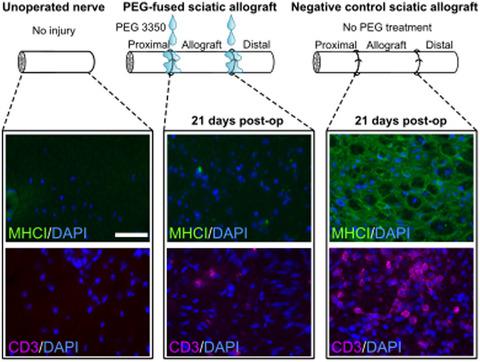当前位置:
X-MOL 学术
›
J. Neurosci. Res.
›
论文详情
Our official English website, www.x-mol.net, welcomes your
feedback! (Note: you will need to create a separate account there.)
Polyethylene glycol-fusion repair of sciatic allografts in female rats achieves immunotolerance via attenuated innate and adaptive responses.
Journal of Neuroscience Research ( IF 2.9 ) Pub Date : 2020-09-15 , DOI: 10.1002/jnr.24720 Tyler A Smith 1 , Cameron L Ghergherehchi 1 , Michelle Mikesh 2 , Jaimie T Shores 3 , Haley O Tucker 1 , George D Bittner 2
Journal of Neuroscience Research ( IF 2.9 ) Pub Date : 2020-09-15 , DOI: 10.1002/jnr.24720 Tyler A Smith 1 , Cameron L Ghergherehchi 1 , Michelle Mikesh 2 , Jaimie T Shores 3 , Haley O Tucker 1 , George D Bittner 2
Affiliation

|
Ablation/segmental loss peripheral nerve injuries (PNIs) exhibit poor functional recovery due to slow and inaccurate outgrowth of regenerating axons. Viable peripheral nerve allografts (PNAs) as growth‐guide conduits are immunologically rejected and all anucleated donor/host axonal segments undergo Wallerian degeneration. In contrast, we report that ablation‐type sciatic PNIs repaired by neurorrhaphy of viable sciatic PNAs and a polyethylene glycol (PEG)‐fusion protocol using PEG immediately restored axonal continuity for many axons, reinnervated/maintained their neuromuscular junctions, and prevented much Wallerian degeneration. PEG‐fused PNAs permanently restored many sciatic‐mediated behaviors within 2–6 weeks. PEG‐fused PNAs were not rejected even though host/donors were neither immunosuppressed nor tissue‐matched in outbred female Sprague Dawley rats. Innate and adaptive immune responses to PEG‐fused sciatic PNAs were analyzed using electron microscopy, immunohistochemistry, and quantitative reverse transcription polymerase chain reaction for morphological features, T cell and macrophage infiltration, major histocompatibility complex (MHC) expression, apoptosis, expression of cytokines, chemokines, and cytotoxic effectors. PEG‐fused PNAs exhibited attenuated innate and adaptive immune responses by 14–21 days postoperatively, as evidenced by (a) many axons and cells remaining viable, (b) significantly reduced infiltration of cytotoxic and total T cells and macrophages, (c) significantly reduced expression of inflammatory cytokines, chemokines, and MHC proteins, (d) consistently low apoptotic response. Morphologically and/or biochemically, PEG‐fused sciatic PNAs often resembled sciatic autografts or intact sciatic nerves. In brief, PEG‐fused PNAs are an unstudied, perhaps unique, example of immune tolerance of viable allograft tissue in a nonimmune‐privileged environment and could greatly improve the clinical outcomes for PNIs relative to current protocols.
中文翻译:

雌性大鼠坐骨同种异体移植物的聚乙二醇融合修复通过减弱的先天和适应性反应实现免疫耐受。
由于再生轴突生长缓慢且不准确,消融/节段性周围神经损伤(PNI)表现出功能恢复不佳。作为生长引导导管的活周围神经同种异体移植物(PNA)会受到免疫排斥,所有无核供体/宿主轴突段都会发生沃勒变性。相比之下,我们报告说,通过可行的坐骨 PNA 的神经缝合和使用 PEG 的聚乙二醇 (PEG) 融合方案修复的消融型坐骨 PNI 立即恢复了许多轴突的轴突连续性,重新支配/维持了它们的神经肌肉接头,并防止了很多沃勒变性。 PEG 融合的 PNA 在 2-6 周内永久恢复了许多坐骨神经介导的行为。即使远交雌性 Sprague Dawley 大鼠的宿主/供体既没有免疫抑制也没有组织匹配,PEG 融合的 PNA 没有被排斥。使用电子显微镜、免疫组织化学和定量逆转录聚合酶链反应分析对 PEG 融合坐骨 PNA 的先天性和适应性免疫反应的形态特征、T 细胞和巨噬细胞浸润、主要组织相容性复合体 (MHC) 表达、细胞凋亡、细胞因子表达、趋化因子和细胞毒性效应子。术后 14-21 天,PEG 融合的 PNA 表现出减弱的先天性和适应性免疫反应,如 (a) 许多轴突和细胞仍然存活,(b) 细胞毒性和总 T 细胞和巨噬细胞的浸润显着减少,(c) 显着减少炎症细胞因子、趋化因子和 MHC 蛋白的表达减少,(d) 细胞凋亡反应持续较低。从形态学和/或生物化学角度来看,PEG 融合的坐骨 PNA 通常类似于坐骨自体移植物或完整的坐骨神经。 简而言之,PEG 融合的 PNA 是一个未经研究的、也许是独特的、在非免疫特权环境中对可行的同种异体移植组织进行免疫耐受的例子,相对于当前的方案,可以极大地改善 PNI 的临床结果。
更新日期:2020-10-19
中文翻译:

雌性大鼠坐骨同种异体移植物的聚乙二醇融合修复通过减弱的先天和适应性反应实现免疫耐受。
由于再生轴突生长缓慢且不准确,消融/节段性周围神经损伤(PNI)表现出功能恢复不佳。作为生长引导导管的活周围神经同种异体移植物(PNA)会受到免疫排斥,所有无核供体/宿主轴突段都会发生沃勒变性。相比之下,我们报告说,通过可行的坐骨 PNA 的神经缝合和使用 PEG 的聚乙二醇 (PEG) 融合方案修复的消融型坐骨 PNI 立即恢复了许多轴突的轴突连续性,重新支配/维持了它们的神经肌肉接头,并防止了很多沃勒变性。 PEG 融合的 PNA 在 2-6 周内永久恢复了许多坐骨神经介导的行为。即使远交雌性 Sprague Dawley 大鼠的宿主/供体既没有免疫抑制也没有组织匹配,PEG 融合的 PNA 没有被排斥。使用电子显微镜、免疫组织化学和定量逆转录聚合酶链反应分析对 PEG 融合坐骨 PNA 的先天性和适应性免疫反应的形态特征、T 细胞和巨噬细胞浸润、主要组织相容性复合体 (MHC) 表达、细胞凋亡、细胞因子表达、趋化因子和细胞毒性效应子。术后 14-21 天,PEG 融合的 PNA 表现出减弱的先天性和适应性免疫反应,如 (a) 许多轴突和细胞仍然存活,(b) 细胞毒性和总 T 细胞和巨噬细胞的浸润显着减少,(c) 显着减少炎症细胞因子、趋化因子和 MHC 蛋白的表达减少,(d) 细胞凋亡反应持续较低。从形态学和/或生物化学角度来看,PEG 融合的坐骨 PNA 通常类似于坐骨自体移植物或完整的坐骨神经。 简而言之,PEG 融合的 PNA 是一个未经研究的、也许是独特的、在非免疫特权环境中对可行的同种异体移植组织进行免疫耐受的例子,相对于当前的方案,可以极大地改善 PNI 的临床结果。











































 京公网安备 11010802027423号
京公网安备 11010802027423号